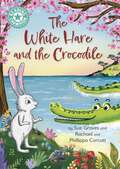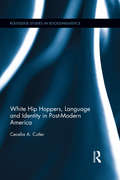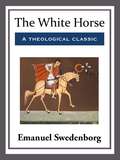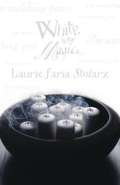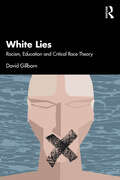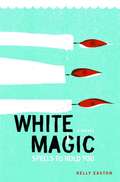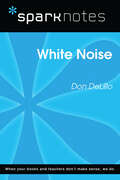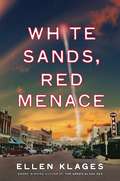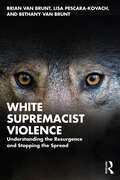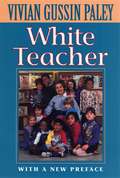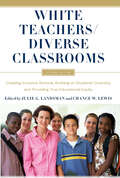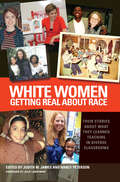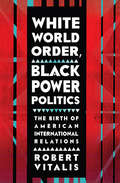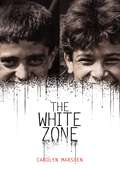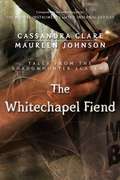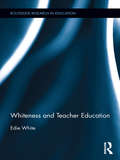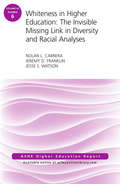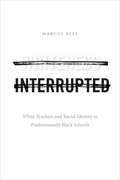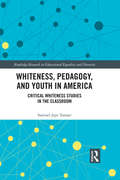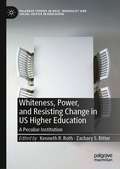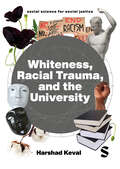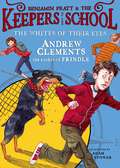- Table View
- List View
The White Hare and the Crocodile: Independent Reading Turquoise 7 (Reading Champion #1076)
by Sue GravesIn this Japanese traditional tale, a little white hare longs to see the world, and he wants to trick a crocodile into helping him.This story is part of Reading Champion, a series carefully linked to book bands to encourage independent reading skills, developed with Dr Sue Bodman and Glen Franklin of UCL Institute of Education (IOE)Reading Champion offers independent reading books for children to practise and reinforce their developing reading skills.Fantastic stories are accompanied by engaging artwork and a reading activity. Each book has been carefully graded so that it can be matched to a child's reading ability, encouraging reading for pleasure.
White Hip Hoppers, Language and Identity in Post-Modern America: White Hip-hoppers, Language And Identity In Post-modern America (Routledge Studies in Sociolinguistics #8)
by Cecelia CutlerThis book examines language and identity among White American middle and upper-middle class youth who affiliate with Hip Hop culture. Hip Hop youth engage in practices that range from the consumption of rap music and fashion to practices like MC-ing (writing and performing raps or "rhymes"), DJ-ing (mixing records to produce a beat for the MC), graffiti tagging, and break-dancing. Cutler explores the way in which these young people stylize their speech using linguistic resources drawn from African American English and Hip Hop slang terms. She also looks at the way they construct their identities in discussions with their friends, and how they talk about and use language to construct themselves as authentic within Hip Hop. Cutler considers the possibility that young people experimenting with AAVE-styled speech may improve the status of AAVE in the broader society. She also addresses the need for educators to be aware of the linguistic patterns found in AAVE and Hip Hop language, and ways to build on Hip Hop skills like rhyming and rapping in order to motivate students and promote literacy.
The White Horse
by Emanuel SwedenborgSwedenborg discusses the White Horse in Revelation Chapter 19, and the spiritual sense of the Word.
White Is For Magic
by Laurie Faria StolarzA year has passed since Stacey Brown saved her best friend from a horrible death. Now she's having nightmares again, haunted by ghosts of the brutally murdered . . . and by a crazed stalker. As she desperately casts healing spells, a new student named Jacob enters her world. Beautiful and mysterious, he reveals that he is also having dreams. To stop a killer, they must join together. But can Jacob be trusted? Or will this new love cause her darkest dreams to come true?
White Lies: Racism, Education and Critical Race Theory
by David GillbornUnpacking Critical Race Theory (CRT) and exploring why it has become a focus in politics across the US and the UK, White Lies uses CRT to expose the systemic racism that shapes education. It charts the coordinated campaigns – involving think tanks, mainstream media and politicians – that have tried to silence antiracism in the wake of George Floyd's murder and 'Black Lives Matter'.Each chapter is devoted to exposing a key ‘white lie’ by examining the evidence that shows how the interests of white people continue to occupy centre stage and block movement towards a more equitable education for all. Gillborn establishes how the public debates, shaped by misinformation and 'white lies', sustain race inequity and portray antiracism as a threat to freedom and justice. Key controversies are dissected and debunked, including: the extensive and coordinated anti-CRT campaigns in the US and the UK; the use of racial gaslighting to undermine claims to social justice; how multiple forms of intimidation are used to silence antiracist teaching and protest; the inaccurate portrayal of the white working class as race victims; and how cruelty, in policy, aims to unify whites and demonize minorities. By avoiding unnecessary jargon to make complex debates accessible to a wide audience, this book is ideal reading for anyone studying CRT or interested in the topic of contemporary educational equality.
White Magic: Spells to Hold You
by Kelly EastonNeed to attract a boy? Cure a fear? Let go of the past? Yvonne has the spell for you. After Chrissie's dad dies, her mom moves them to California to remarry. Chrissie's lonely new life is transformed when the amazing Yvonne jumps out of her apartment door and pulls Chrissie inside to join Yvonne and Karen in their coven of "good witches." Yvonne is part gypsy, and somehow wiser than other kids her age. Karen is sweet, shy, and madly in love with the wrong boy. Alone, each girl is an outsider; but when the friends share their powers and cast spells to help each other, a kind of magic starts to happen.
White Middle-Class Identities and Urban Schooling
by Diane Reay Gill Crozier David JamesThis book examines experiences and implications of 'against-the-grain' school choices, where white middle class families choose ordinary and 'low performing' secondary schools for their children. It offers a unique view of identity formation, taking in matters like family history, locality and whiteness.
White Noise (SparkNotes Literature Guide Series)
by SparkNotesWhite Noise (SparkNotes Literature Guide) by Don DeLillo Making the reading experience fun! Created by Harvard students for students everywhere, SparkNotes is a new breed of study guide: smarter, better, faster. Geared to what today's students need to know, SparkNotes provides: *Chapter-by-chapter analysis *Explanations of key themes, motifs, and symbols *A review quiz and essay topicsLively and accessible, these guides are perfect for late-night studying and writing papers
White Sands, Red Menace
by Ellen KlagesIt is 1946, and the events of The Green Glass Seahave changed the world and Dewey Kerrigan's life. She's now living near the White Sands Missile Range in New Mexico with the Gordon family. Dr. Gordon is working on rockets that will someday go to the moon; Mrs. Gordon is working on stopping the Bomb. Meanwhile, Dewey and her sister, Suze, share secrets, art, and science as they adjust to high school in an isolated desert town. Then, like a different kind of dropped bomb, Dewey's long-lost mother, Rita Gallucci, reappears in their lives. And she wants to take her daughter away.
White Supremacist Violence: Understanding the Resurgence and Stopping the Spread
by Brian Van Brunt Lisa Pescara-Kovach Bethany Van BruntWhite Supremacist Violence is a powerful resource for education and mental health professionals who are developing the tools and skills needed to slow the progress of the fast-growing hate movement in the United States. Chapters immerse the reader in a hybrid of research, historical reviews, current events, social media and online content, case studies, and personal experiences. The first half of the text explores the ways in which individuals become increasingly indoctrinated through the exploitation of cognitive openings, perceptions of real or imagined marginalization, and exposure to political rhetoric and manipulation, as well as an examination of social media and commerce sites that create a climate ripe for recruitment. The second half of the book walks the reader through three case studies and offers treatment considerations to assist mental-health professionals and those developing education and prevention-based programming. White Supremacist Violence gives readers useful perspectives and insights into the white supremacy movement while offering clinicians, threat-assessment professionals, and K-12 and university educators and administrators practical guidance on treatment and prevention efforts.
White Teacher
by Vivian Gussin PaleyVivian Paley presents a moving personal account of her experiences teaching kindergarten in an integrated school within a predominantly white, middle-class neighborhood. In a new preface, she reflects on the way that even simple terminology can convey unintended meanings and show a speaker's blind spots. She also vividly describes what her readers have taught her over the years about herself as a "white teacher."
White Teacher: With a New Preface, Third Edition
by Vivian Gussin PaleyVivian Paley presents a moving personal account of her experiences teaching kindergarten in an integrated school within a predominantly white, middle-class neighborhood. In a new preface, she reflects on the way that even simple terminology can convey unintended meanings and show a speaker's blind spots. She also vividly describes what her readers have taught her over the years about herself as a "white teacher."
White Teachers / Diverse Classrooms: Creating Inclusive Schools, Building on Students’ Diversity, and Providing True Educational Equity
by Julie G. Landsman Chance W. Lewis· Interviews with Black students and experienced educators provide guidance on how to teach successfully in multicultural classes· Insights and ideas to promote observation, reflection, and effective classroom practice· Ideal for initiating constructive discussion in pre-service courses, and for professional development· Defines the seven characteristics of successful multicultural teaching· Based on the acclaimed book These interviews with Black students, White and Black teachers, educational experts and school administrators poignantly bring to life the issues, strategies and competencies that teachers need to engage with–if they are to create the conditions that will enable their students of color to succeed and excel.From these candid, unscripted interviews, there emerge seven key drivers of inclusive teaching.The ideas and insights captured in this DVD are placed in context by short introductory and concluding commentaries by the editors of the acclaimed companion book, White Teachers / Diverse Classrooms.The feature 33 minute track is enhanced by a further 83 minutes of additional footage that presents more extensive interviews with many of the participants, to add depth to pedagogical approaches they advocate.This DVD is effective both for group viewing and discussion, and for individual study. It will spur debate, stimulate ideas and reflection, and inspire.White Teachers / Diverse Classrooms DVDRegion: 0 / NTSC. Can be played on any computer worldwide / Plays on North American TVs onlyClosed captioning for the hearing impaired. Includes educational performance rights.
White Women Getting Real About Race: Their Stories About What They Learned Teaching in Diverse Classrooms
by Julie Landsman Judith M. James Nancy PetersonFor many White women teachers and teachers in training – who represent the majority of our teaching force today – the issue of race is fraught with discomfort. It may challenge assumptions, evoke a sense of guilt, or give rise to a fear of making mistakes or saying the wrong thing.This book presents the first-person stories of White women teachers who tell us not only how they have grappled with race in diverse classrooms, but how they continue to this day to be challenged by issues of color and privilege. These are no stories of heroic feats or achievement of perfection, but stories of self-disclosure that lay bare their authors’ emotions, ideas, curiosity, vulnerability, and reflections as they engaged with race, and challenged practices of color blindness and empathetic distance. Avoiding abstract educational lingo, these teachers come clean about the emotional cost of dealing with racism, White privilege, and fear of being racist in our rapidly diversifying schools. Admitting their cultural mistakes, they hope their readers can find a safe place to use theirs for honest dialogue and positive learning.In approaching chapter authors for this book, the editors asked the writers to ask themselves, “Will my well-being and sense of self be at risk if I tell this story?” Recognizing what’s at stake, they wanted writers who would be real with themselves.The women in this book hope that their stories will resonate with readers, help them feel less alone, and give them courage to begin a dialogue with colleagues, friends, staff and administrators around race concerns. Each chapter concludes with a few questions to prompt self-reflection at home, or for use as exercises to use in small groups or staff development training.
White World Order, Black Power Politics: The Birth of American International Relations
by Robert VitalisRacism and imperialism are the twin forces that propelled the course of the United States in the world in the early twentieth century and in turn affected the way that diplomatic history and international relations were taught and understood in the American academy. Evolutionary theory, social Darwinism, and racial anthropology had been dominant doctrines in international relations from its beginnings; racist attitudes informed research priorities and were embedded in newly formed professional organizations. In White World Order, Black Power Politics, Robert Vitalis recovers the arguments, texts, and institution building of an extraordinary group of professors at Howard University, including Alain Locke, Ralph Bunche, Rayford Logan, Eric Williams, and Merze Tate, who was the first black female professor of political science in the country. Within the rigidly segregated profession, the "Howard School of International Relations" represented the most important center of opposition to racism and the focal point for theorizing feasible alternatives to dependency and domination for Africans and African Americans through the early 1960s. Vitalis pairs the contributions of white and black scholars to reconstitute forgotten historical dialogues and show the critical role played by race in the formation of international relations.
The White Zone (Exceptional Reading And Language Arts Titles For Intermediate Grades Ser.)
by Carolyn MarsdenNouri and his cousin Talib can only vaguely remember a time before tanks rumbled over the streets of their Baghdad neighborhood—when books, not bombs, ruled Mutanabbi Street. War has been the backdrop of their young lives. And now Iraq isn't just at war with Americans. It's at war with itself. Sunnis fight Shiites, and the strife is at the boys' doorsteps. Nouri is Shiite and Talib is half Sunni. To the boys, it seems like only a miracle can mend the rift that is tearing a country and a family apart. In early 2008, Iraq experienced a miracle. Snow fell in Baghdad for the first time in living memory. As snow covered the dusty streets, the guns in the city grew silent and there was an unofficial ceasefire. During these magical minutes, Sunni and Shiite differences were forgotten. There was no green zone, no red zone. There was only the white zone. Against this real-life backdrop, Nouri and Talib begin to imagine a world after the war.
The Whitechapel Fiend
by Maureen Johnson Cassandra ClareJack the Ripper stalks through London, and only the Shadowhunters can stop him. One of ten adventures in Tales from the Shadowhunter Academy.Simon learns the truth behind the Jack the Ripper murders--"Jack" was stopped by Will Herondale and his institute of Victorian Shadowhunters.This standalone e-only short story follows the adventures of Simon Lewis, star of the #1 New York Times bestselling series The Mortal Instruments, as he trains to become a Shadowhunter. Tales from the Shadowhunter Academy features characters from Cassandra Clare's Mortal Instruments, Infernal Devices, and the upcoming Dark Artifices and Last Hours series. The Whitechapel Fiend is written by Cassandra Clare and Maureen Johnson.
Whiteness and Teacher Education (Routledge Research in Education)
by Edie WhiteDue to the rise of internet use and a move toward globalization, it may be assumed that white millennial college students are more accepting of cultural diversity and are more likely to be advocates for social justice than generations that have come before them. This project shows that while many white students know how to speak the language of "correctness" and to some degree even believe in what they are saying, their limited personal experiences with those who are racially different from themselves often bump against their beliefs about racial acceptance and equality. This project investigates the ways that one facet of identity, whiteness, influences teachers’ understanding of their roles in the schools and informs their decision making within their practice. It explores several life stories of five teacher candidates, all born after 1985. Through these stories we get a sense of how white prospective teachers imagine themselves as teachers of diverse students and how they imagine developing equitable practices. This work advocates that teacher educators help pre-service teachers unpack and understand their biases in order to facilitate their students in balancing their life experiences with whom they imagine themselves to be as teachers.
Whiteness in Higher Education: The Invisible Missing Link in Diversity and Racial Analyses: ASHE Higher Education Report, Volume 42, Number 6 (J-B ASHE Higher Education Report Series (AEHE))
by Nolan L. Cabrera Jeremy D. Franklin Jesse S. WatsonWhen issues of diversity and race arise in higher education scholarship and practice, the focus is generally on Students of Color. That being said, if there are People of Color being marginalized on college campuses, there is a structural mechanism facilitating the marginalization. This monograph explores the relevance of Whiteness to the field of Higher Education. While Whiteness as a racial discourse is continually changing and defies classification, it is both real in terms of its impacts on the campus racial dynamics. Highlighting many of the contours of Whiteness in higher education, this volume explores the influence of Whiteness on interpersonal interactions, campus climate, culture, ecology, policy, and scholarship. Additionally, it explores what can be done—both individually and institutionally—to address the problem of Whiteness in higher education. Ultimately, this monograph is offered from the perspective that racial issues concern everyone, and this engages the possibility of both People of Color destabilizing Whiteness and White people becoming racial justice allies within the context of higher education institutions.This is the sixth issue of the 42nd volume of the Jossey-Bass series ASHE Higher Education Report. Each monograph is the definitive analysis of a tough higher education issue, based on thorough research of pertinent literature and institutional experiences. Topics are identified by a national survey. Noted practitioners and scholars are then commissioned to write the reports, with experts providing critical reviews of each manuscript before publication.
Whiteness Interrupted: White Teachers and Racial Identity in Predominantly Black Schools
by Marcus BellIn Whiteness Interrupted Marcus Bell presents a revealing portrait of white teachers in majority-black schools in which he examines the limitations of understandings of how white racial identity is formed. Through in-depth interviews with dozens of white teachers from a racially segregated, urban school district in Upstate New York, Bell outlines how whiteness is constructed based on localized interactions and takes a different form in predominantly black spaces. He finds that in response to racial stress in a difficult teaching environment, white teachers conceptualized whiteness as a stigmatized category predicated on white victimization. When discussing race outside majority-black spaces, Bell's subjects characterized American society as postracial, in which race seldom affects outcomes. Conversely, in discussing their experiences within predominantly black spaces, they rejected the idea of white privilege, often angrily, and instead focused on what they saw as the racial privilege of blackness. Throughout, Bell underscores the significance of white victimization narratives in black spaces and their repercussions as the United States becomes a majority-minority society.
Whiteness, Pedagogy, and Youth in America: Critical Whiteness Studies in the Classroom (Routledge Research in Educational Equality and Diversity)
by Samuel Jaye TannerThis book employs a narrative approach to recount and interpret the story of an innovative teaching and learning project about whiteness. By offering a first-hand description of a nationally-recognized, high school-based Youth Participatory Action Research project—The Whiteness Project—this book draws out the conflicts and complexities at the core of white students’ racial identities. Critical of the essentializing frameworks traditionally given to address white privilege, this volume advances a distinctive and theoretically robust account of ‘second-wave critical whiteness pedagogy’.
Whiteness, Power, and Resisting Change in US Higher Education: A Peculiar Institution (Palgrave Studies in Race, Inequality and Social Justice in Education)
by Zachary S. Ritter Kenneth R. RothThis edited volume connects the origins of US higher education during the Colonial Era with current systemic characteristics that maintain white supremacist structures and devalue students and faculty of color, as well as areas of study that interrogate Whiteness. The authors examine power structures within the academy that scaffold Whiteness and promote inequality at all levels by maintaining a two-tier faculty system and a dearth of Faculty and Administrators of Color. Finally, contributors offer systemic and collective solutions toward a more equitable redistribution of power, primarily among faculty and administration, through which other inequities may be identified and more easily addressed.
Whiteness, Racial Trauma, and the University: Experiencing Whiteness in the University (Social Science for Social Justice)
by Harshad KevalUniversities are regarded as safe havens for knowledge production and the educational transformation of lives. There is, however, a long history of universities as sites of contestation where structures of hierarchical legitimacy are played out. In response to the upsurge in global protests against racial violence and the criticism of colonial, racialised and Eurocentric forms of thinking, universities have adopted new roles as ‘anti-racist’ and ‘decolonial’ beacons of hope. This book unravels how such liberal progressive ‘acts’ hide a much deeper racialised logic of whiteness-framed structural narcissism, producing insidiously powerful and difficult to trace forms of racialised harm. The Social Science for Social Justice series challenges the Ivory Tower of academia, providing a platform for academics, journalists, and activists of color to respond to pressing social issues.
Whiteness, Racial Trauma, and the University: Experiencing Whiteness in the University (Social Science for Social Justice)
by Harshad KevalUniversities are regarded as safe havens for knowledge production and the educational transformation of lives. There is, however, a long history of universities as sites of contestation where structures of hierarchical legitimacy are played out. In response to the upsurge in global protests against racial violence and the criticism of colonial, racialised and Eurocentric forms of thinking, universities have adopted new roles as ‘anti-racist’ and ‘decolonial’ beacons of hope. This book unravels how such liberal progressive ‘acts’ hide a much deeper racialised logic of whiteness-framed structural narcissism, producing insidiously powerful and difficult to trace forms of racialised harm. The Social Science for Social Justice series challenges the Ivory Tower of academia, providing a platform for academics, journalists, and activists of color to respond to pressing social issues.
The Whites of Their Eyes: We The Children; Fear Itself; The Whites Of Their Eyes; In Harm's Way; We Hold These Truths (Benjamin Pratt and the Keepers of the School #3)
by Andrew Clements Adam StowerAndrew Clements delivers the latest in his adventure-filled school series. This could be the last great Memorial Day weekend on Barclay Bay, and Ben knows it. <P><P>This time next year, he might not be able to stand in the yard of the Oakes School and watch the harbor shake off winter--boats buzzing just beyond the bulkhead and families spreading picnics in the fields. <P><P>If the school gets torn down and replaced by an amusement park, the town will never be the same. But that's only if the school gets torn down. Ben and Jill are determined to keep that from happening. <P>And the evil janitor Lyman has taken note. He's following their every move--and undoing their progress along the way. Good thing Ben and Jill have a secret weapon. (Who knew that annoying Robert Gerritt would be such a spy wiz?) <P><P>But Lyman has a secret weapon as well: a vicious guard dog. <P>These kids are smart, but can they outsmart Lyman--and his beast--as the clock tick, tick, ticks toward total demolition? <P><b>Lexile: 810L</b>
